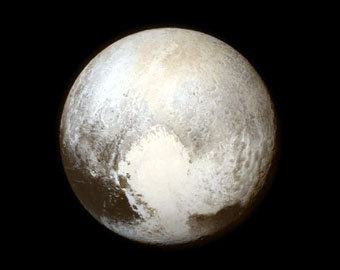
A Close-Up Look at Distant Pluto
| published July 14, 2015 |
By Keith Roberts Thursday Review contributor
The decade long trek of the New Horizons spacecraft is reaching the crescendo of its long-endurance mission. NASA says that New Horizons is approximately 7,750 miles above Pluto’s pockmarked and chilly surface, as close as human-engineered eyes have ever come to the planet once temporarily kicked out of the elite club of planets in our solar system.
The Long Range Reconnaissance Imager (LORRI), New Horizons’ specially designed camera, has been steadily capturing images of the distant planet with each passing hour. Because the images take many hours for their signal to reach us here on Earth (the black and white imagery arrives first, then the color data later; images are then colorized appropriately by computers), the photo here was actually taken from some 476,000 miles above the surface. That’s good news, of course, because it means that photos of even higher quality will be arriving here on Earth over the next few days.
This photo is the closest image yet delivered to NASA; taken late on Monday, its details were uploaded early Tuesday. Scientists with the New Horizons team at NASA, at the Jet Propulsion Laboratory in California, and at Johns Hopkins University’s Applied Physics Laboratory in Laurel, Maryland applauded as the images arrived on the large viewing screens.
New Horizons is gathering data as quickly as it can, capturing images and taking detailed measurements as it sails past Pluto over the next hours and days. It will eventually transmit all that information in stages back to Earth, assuming that its programming has remained intact and it is able to remember its instructions to, as NASA puts it, phone home. Some of that data will take nearly 16 months to arrive, at which time scientists all over the world will be able to begin painting a more detailed portrait of Pluto. In the meantime, the crisp photo images will keep mission specialists busy.
But New Horizons’ overall mission is not over. Its high speed fly-by of Pluto is only the next-to-the-last chapter, as the spacecraft will next move along its charted path toward the Kuiper Belt, of which distant Pluto is a member. The Kuiper Belt is made up of hundreds of thousands—even millions—of objects, some of them ice, some rock, many some combination of both, many of them moon-like, others ragged and rough. Pluto and these Kuiper Belt objects will give scientists one of the deepest looks into how our solar system was formed, and perhaps also inform us as to what to expect in the way of meteors and asteroids.
Most amazingly, New Horizons arrived almost exactly on schedule. Even though it had travelled more than three billion miles at speeds in excess of 30,000 miles per hour—the fastest spacecraft ever launched from Earth—New Horizons arrived at its designated coordinates near Pluto one minute ahead of schedule and precisely within its narrow 57 mile wide target. Only a mile or two outside that window—in time or space—and we would see none of the images of Pluto we now see. More amazingly, since New Horizons was travelling at such breakneck speeds through space, there was the possibility that if it encountered a small rock, micrometeorite, or other disruptive object—even as small as an English pea—the spacecraft might have been battered off course, or even destroyed completely.
Pluto was discovered in 1930 by Clyde Tombaugh, and became the first major solar system object beyond the orbit of Neptune, then considered the most distant planet. Pluto has five major moons: Charon (the largest), Styx, Nix, Kerberos, and Hydra. New Horizons will also accumulate detailed measurements of Pluto’s moons as it passes through the area. Pluto’s membership among the club of planets has been controversial, as it has been considered by many scientists more of a Kuiper Belt object than a per se planet, especially after the discovery in 1992 of the belt, and the subsequent discovery in 2005 of Eris, a spherical Kuiper Belt object—very much planet-like—which is 27% larger than Pluto. This has led to a division among astronomers and scientists over the definitions of planets, and whether some object should fall into a new category of “dwarf” planets.
Related Thursday Review articles:
Battered Tethys; Keith H. Roberts; Thursday Review; June 17, 2015.
Youthful Martian Crater; Keith H. Roberts; Thursday Review; June 10, 2015.
